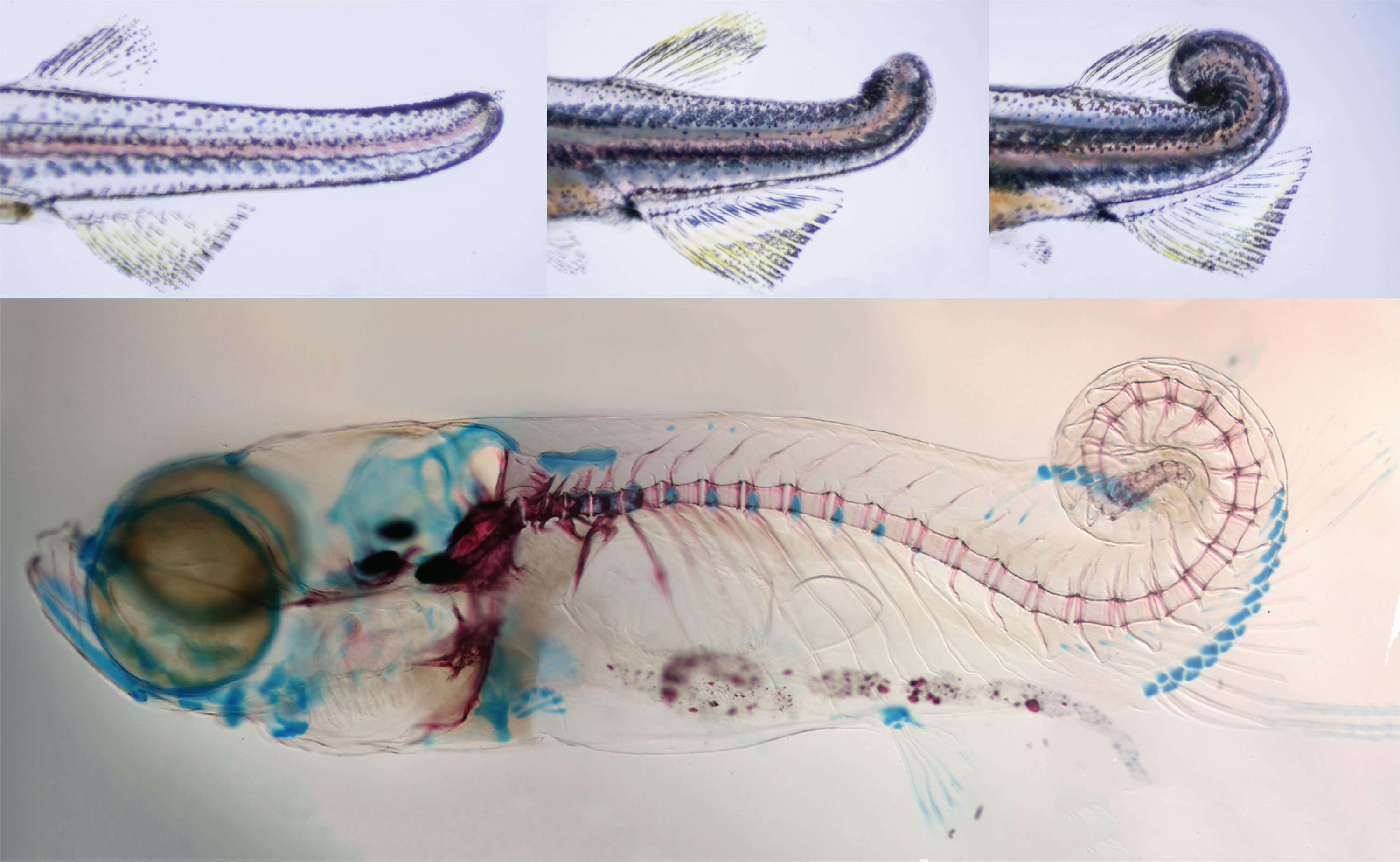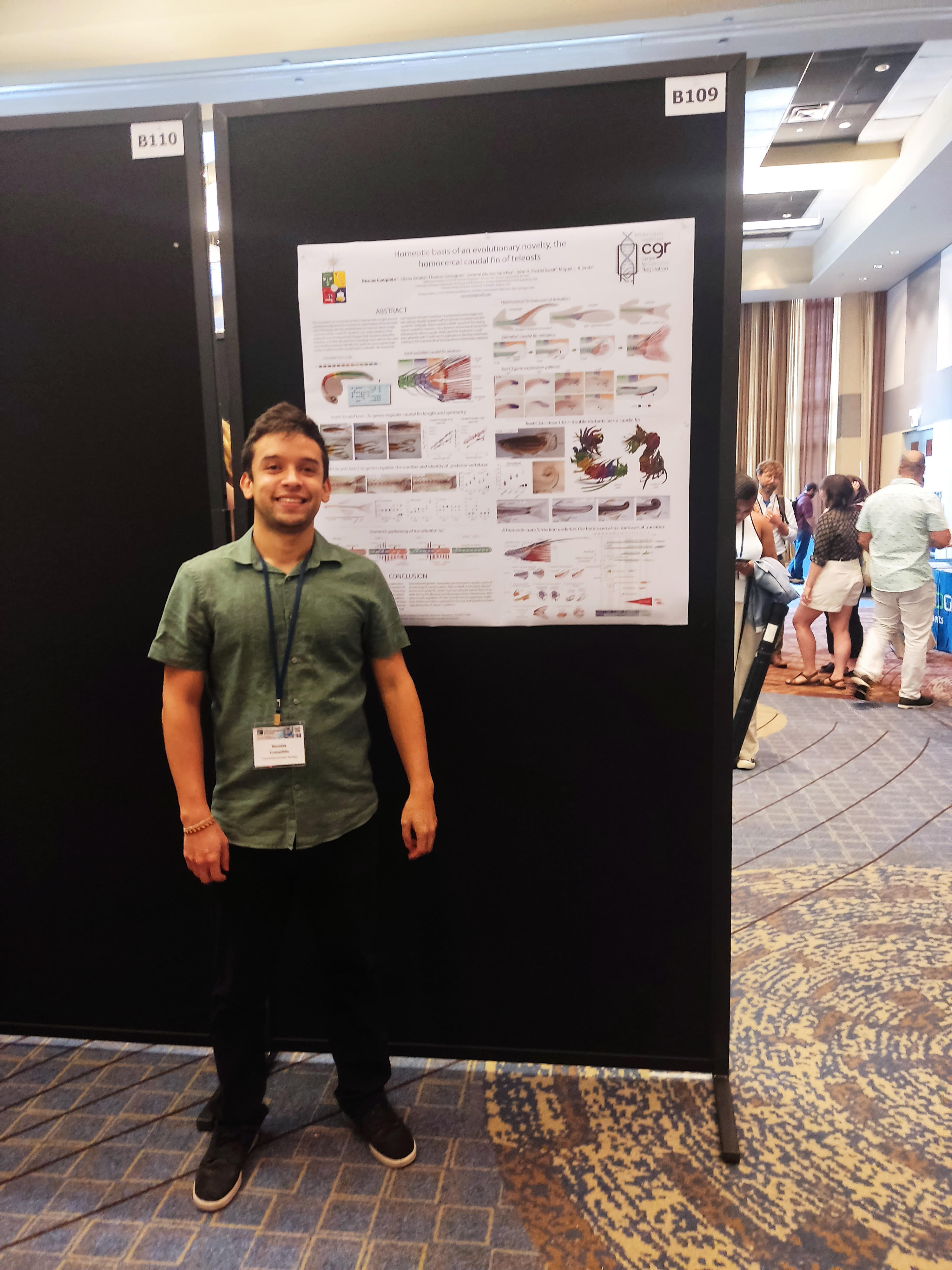CRISPR-Cas9-induced mutations in the zebrafish model have allowed us to understand the changes that occurred in fish evolution in the fossil record. The research, a doctoral thesis by Nicolas Compledo at the University of Chile's Faculty of Science, concluded that several processes led to the tail shape possessed by modern fish (called the tail of Homocerca because of its dorsal-ventral symmetry). It is possible that it is mediated by modification of Hox13 genes in the regulatory network that controls the shape of this structure.
On January 19, the journal Science Advances published a research article titled “Hox genes control development and evolution of homologous caudal fins.” Results obtained experimentally using zebrafish and through paleontological analysis of fossil fish provide highly relevant information on evolution, growth biology, and morphology. In this group of vertebrates. The work was carried out by Nicolas Compledo, during his doctoral thesis at the Faculty of Sciences of the University of Chile and the Milenio Institute Center for Genome Regulation (CRG), in collaboration with researchers from the University of Oregon, and under the supervision of Professor Gloria Arratia from the University of Kansas and Professor Miguel L. Allende from the University of Chile and Director of the CRG.
In this article, two Hox genes that control the shape and structural properties of the posterior end of the body of fishes, the largest and oldest group of vertebrates, are described for the first time. Through CRISPR-Cas9-induced mutations in a zebrafish model, the research revealed very striking phenotypes in the terminal parts of the body, resulting in an increased number of tail vertebrae and loss of other bony elements in the tail. One striking phenomenon exhibited by these mutations occurred when both Hox13 genes were mutated: the caudal fin was completely lost and the number of tail vertebrae expanded, forming a long spiral tail, similar to the tail that sea horses have.
These findings led the research group to study the changes that occurred in fish evolution through analysis of the fossil record, concluding that many of the processes that led to the tail shape that modern fish have (called the tail of Homocerca after its dorsal shape) could have been ventral symmetry. ) may be mediated by the integration of Hox13 genes into the regulatory network that controls the shape of this structure.


According to Professor Miguel Allende, an academician in the Department of Biology and director of the Center for the Millennium Institute for Genome Regulation at the University of Chile’s Faculty of Science, this discovery “comes to fill a gap in knowledge that existed.” In terms of what happened historically in the formation of early vertebrates, fish in particular are the oldest vertebrates, so studying them is like looking back at our ancestors. How genes important in body formation, structure, and organization in animals form over time and acquire functions. He stressed that it is a very interesting tool that complements what paleontology and other disciplines do.

He explained, “The first vertebrates had an anterior-posterior axis, a head and a tail, but how did they divide, especially the tail, how did they gain their identity and then change their shape with the passage of time until they became what they are today with all their diversity?” Of fish and other vertebrates, today we can understand them much better with these discoveries. He also said: “Although one might think that the tail of a fish is the least structurally important, it is an interesting problem because you have to think that the back of the body is what gives it propulsion and mobility.” , to navigate the environment and perhaps eventually emerge onto Earth. Thus, it is a structure that has become fundamental in all vertebrate evolutionary transformations.
Nicolás Compledo, Doctor of Science from the University of Chile and currently a postdoctoral researcher at the School of Biological Sciences at the Pontifical Universidad U. Católica de Chile, the lead author of the paper, said it started from a question that had been around since the mid-20th century. 19th century reference to how fish changed their tails, in what was one of the most important evolutionary phenomena in the Mesozoic and allowed them to expand “and colonize the entire Earth,” he explains. “With this evolutionary question, we were able to put together work in a current modern context, using genetics, using genomics, and making modern morphological comparisons.”

He added that one of the concepts we addressed was the use of Hox genes, which locate the structure in the appropriate place. “We are using genetic modification tools to establish a relationship about how these genes contribute to the formation of the caudal fin,” Compledo said. In this sense, he highlighted the innovative nature of the research because it had not been proven.
Professor Miguel Allende also highlighted the CRISPR-Cas9 technology used in the experiments. “I do not recall any other work that has led to the creation of CRISPR mutations in vertebrates in Chile. “It has been challenging and innovative to create vertebrate models made through genetic manipulation to answer a complex question like this that has evolutionary limits.” He also points out that “in parallel, we use More sophisticated methods in comparative paleontological studies and different tools can answer the question of the article. He said that it is an innovative work in terms of technology and approach, adding that it has the bioinformatics element of analyzing data and sequences and comparing sequences with different species. In this regard, he pointed out that CRISPR technology was awarded the 2022 Nobel Prize in Chemistry by researchers Emmanuelle Charpentier (Max Planck Institute, Berlin, Germany) and Jennifer Doudna (University of California, Berkeley, USA).

“Creator. Devoted pop culture specialist. Certified web fanatic. Unapologetic coffee lover.”
